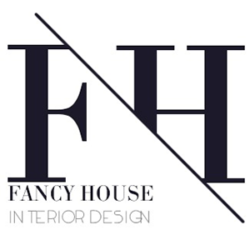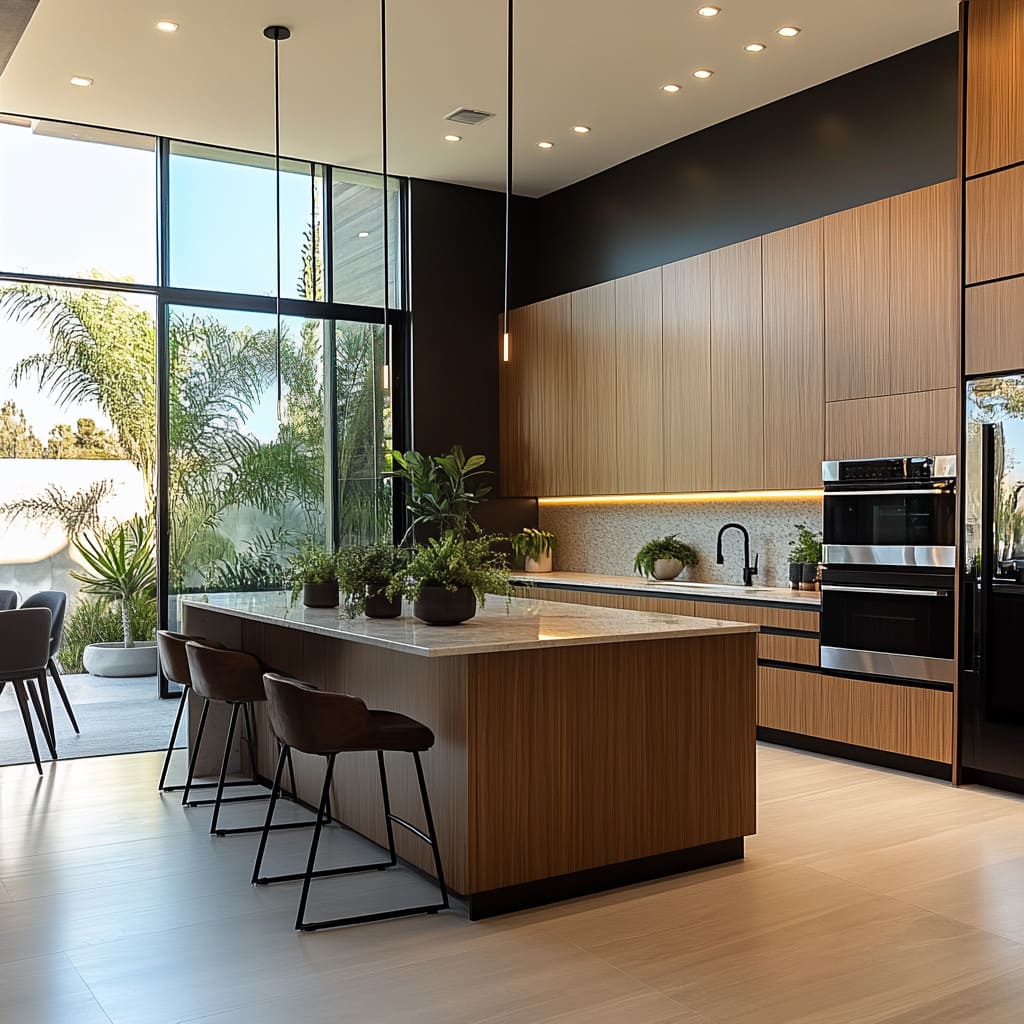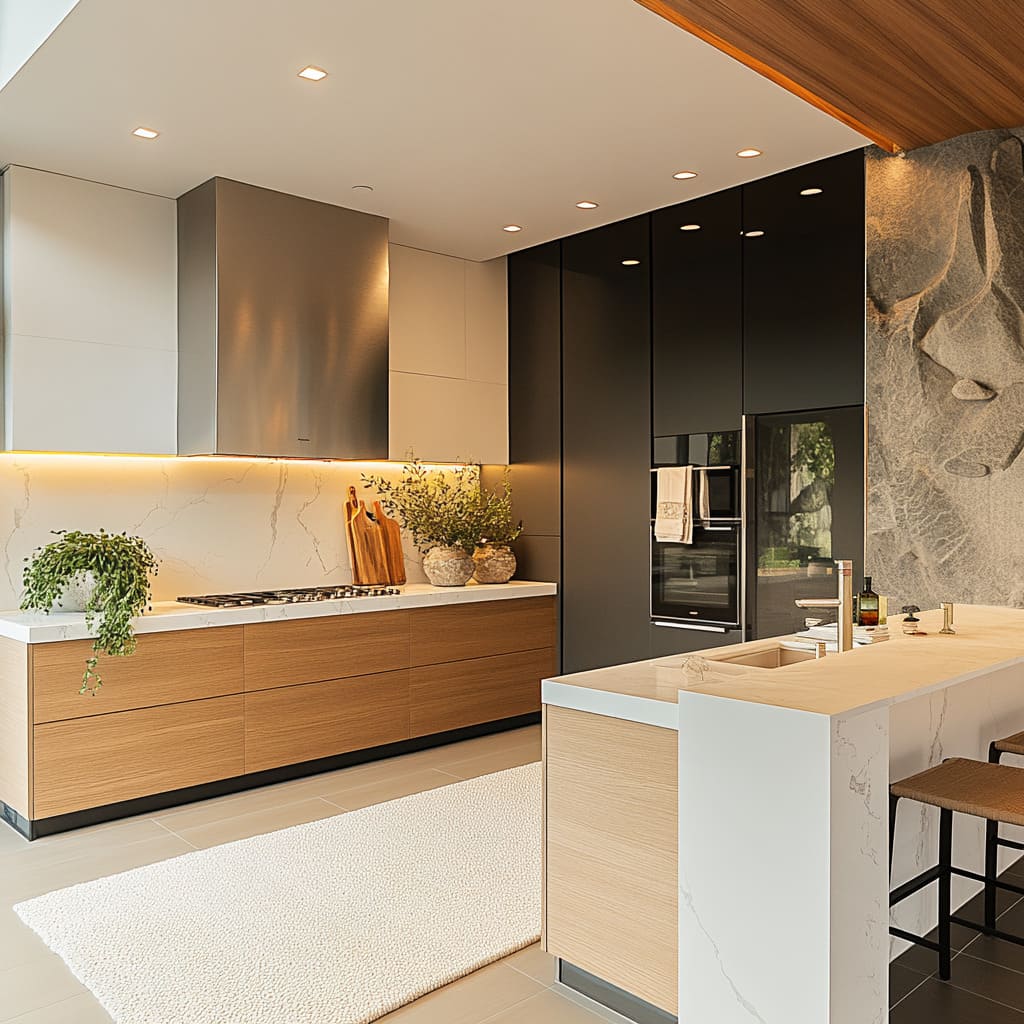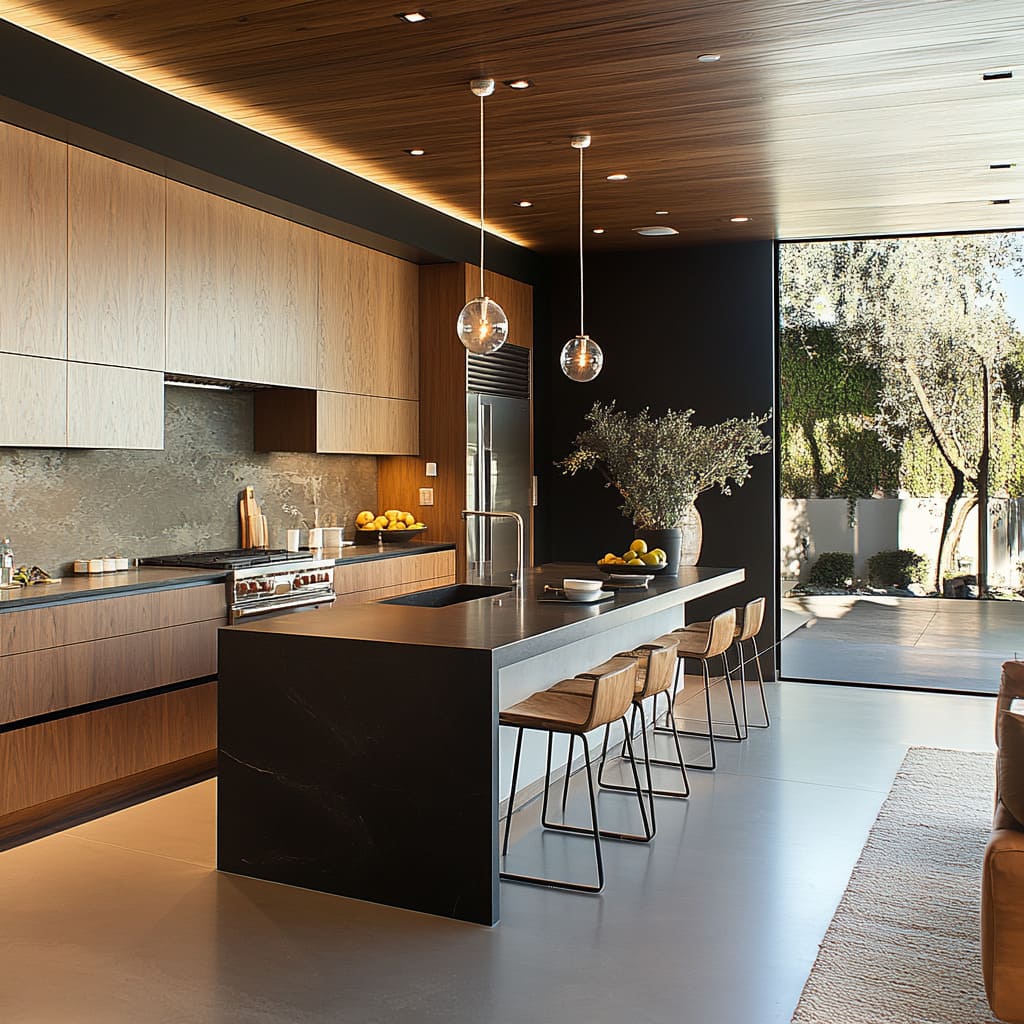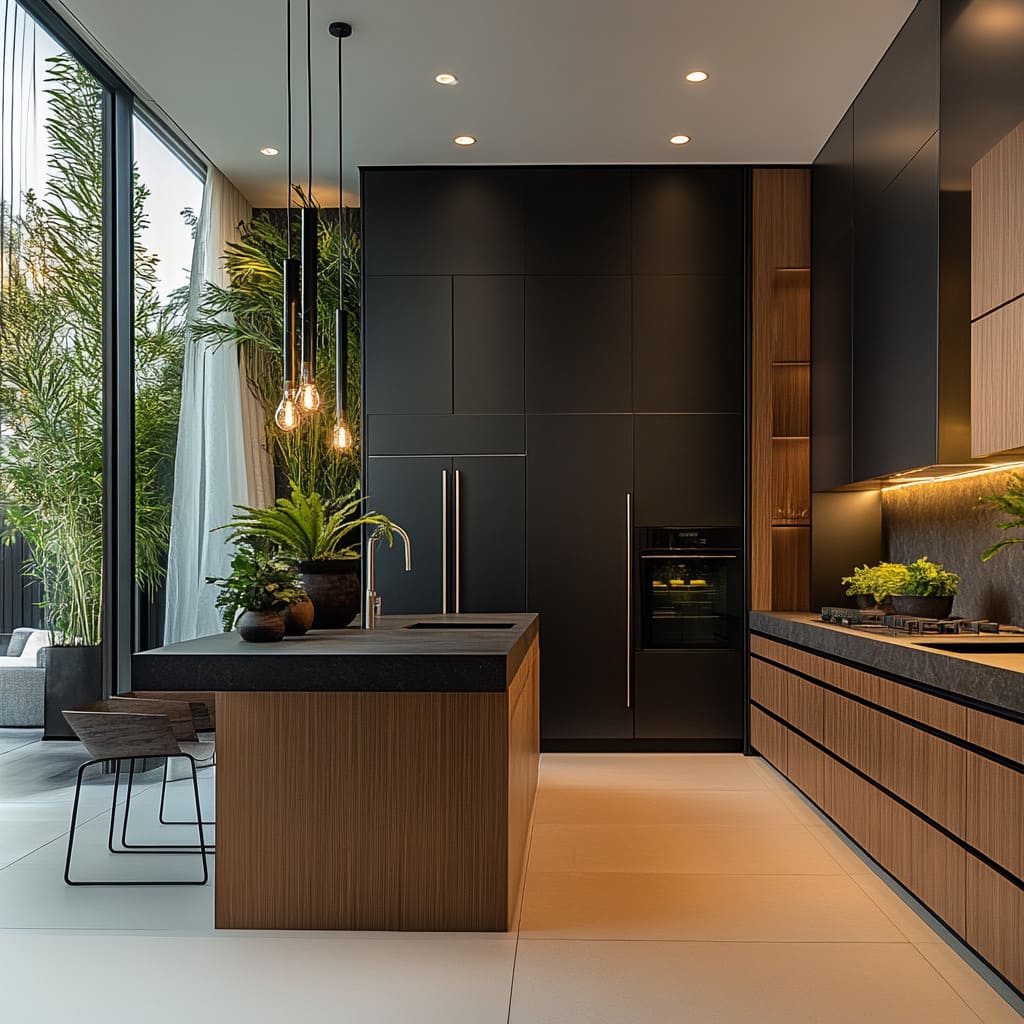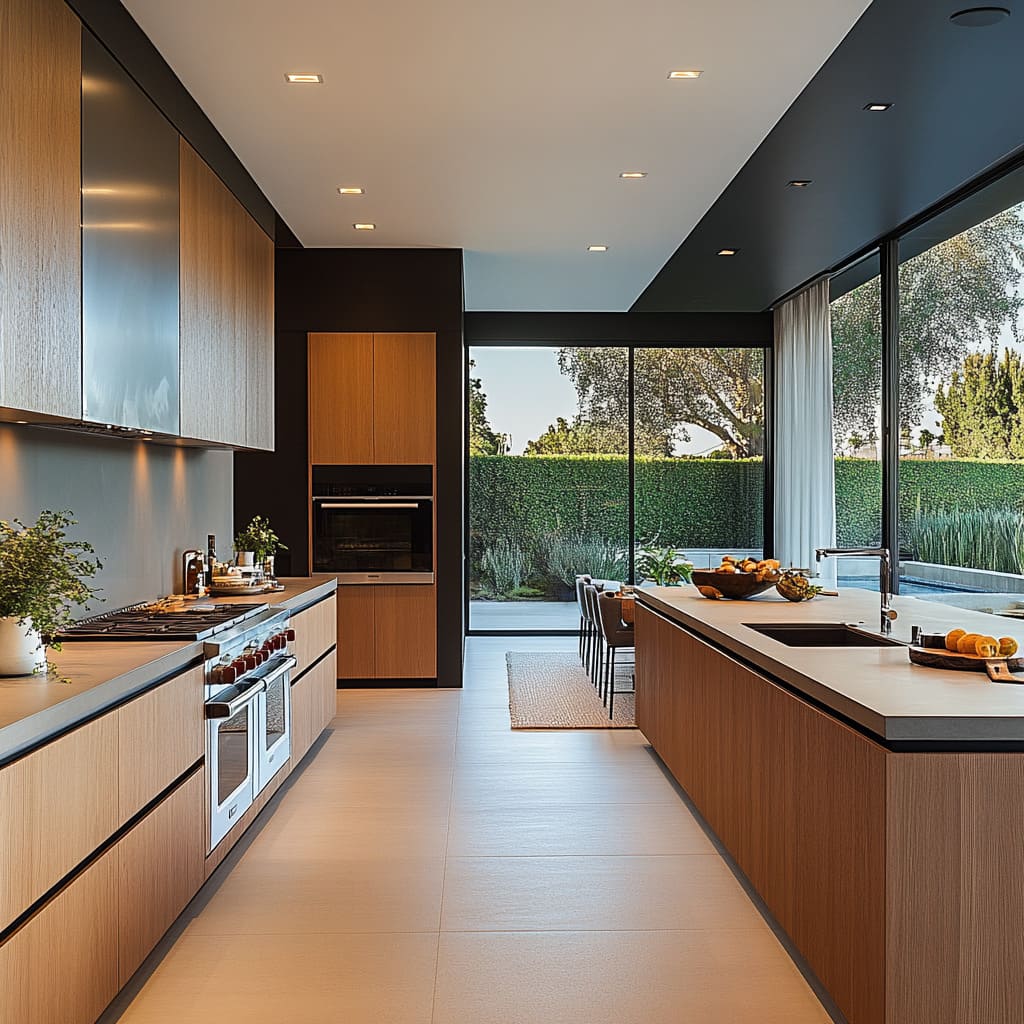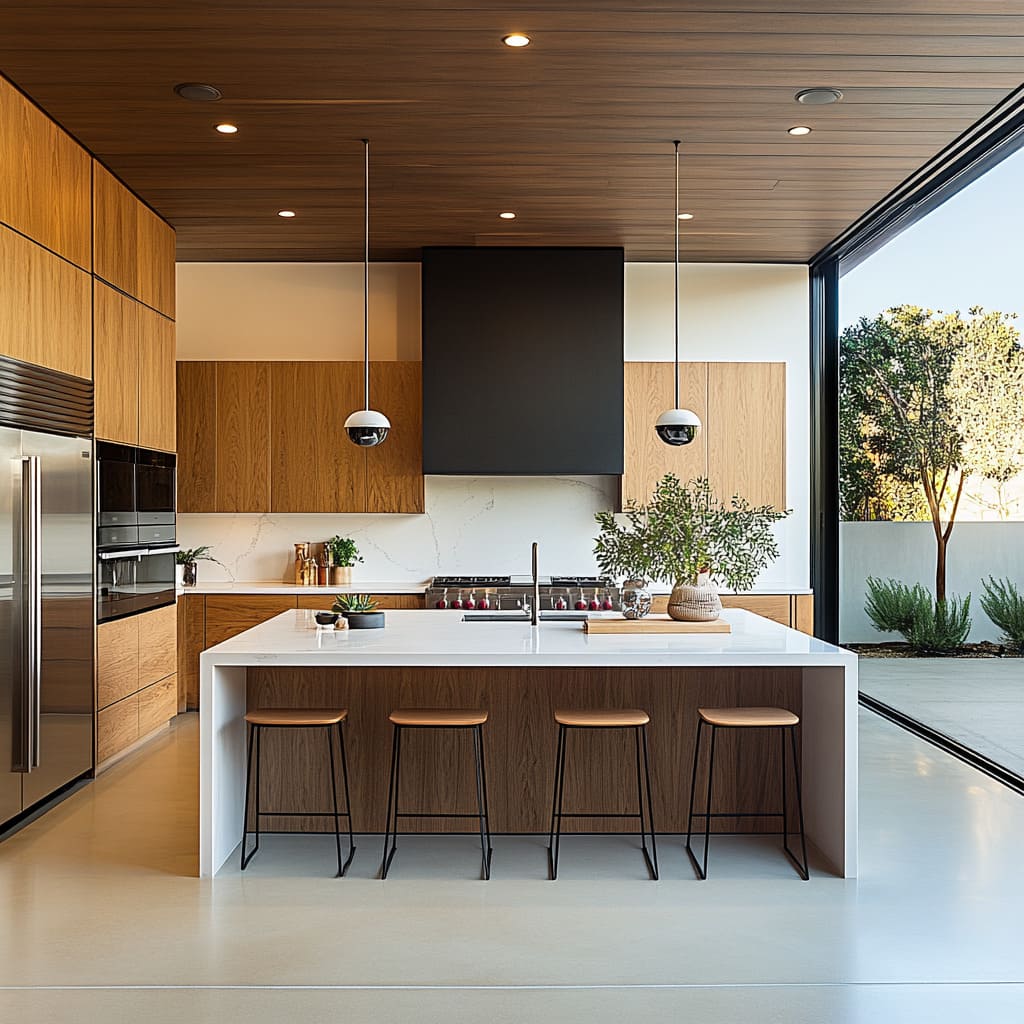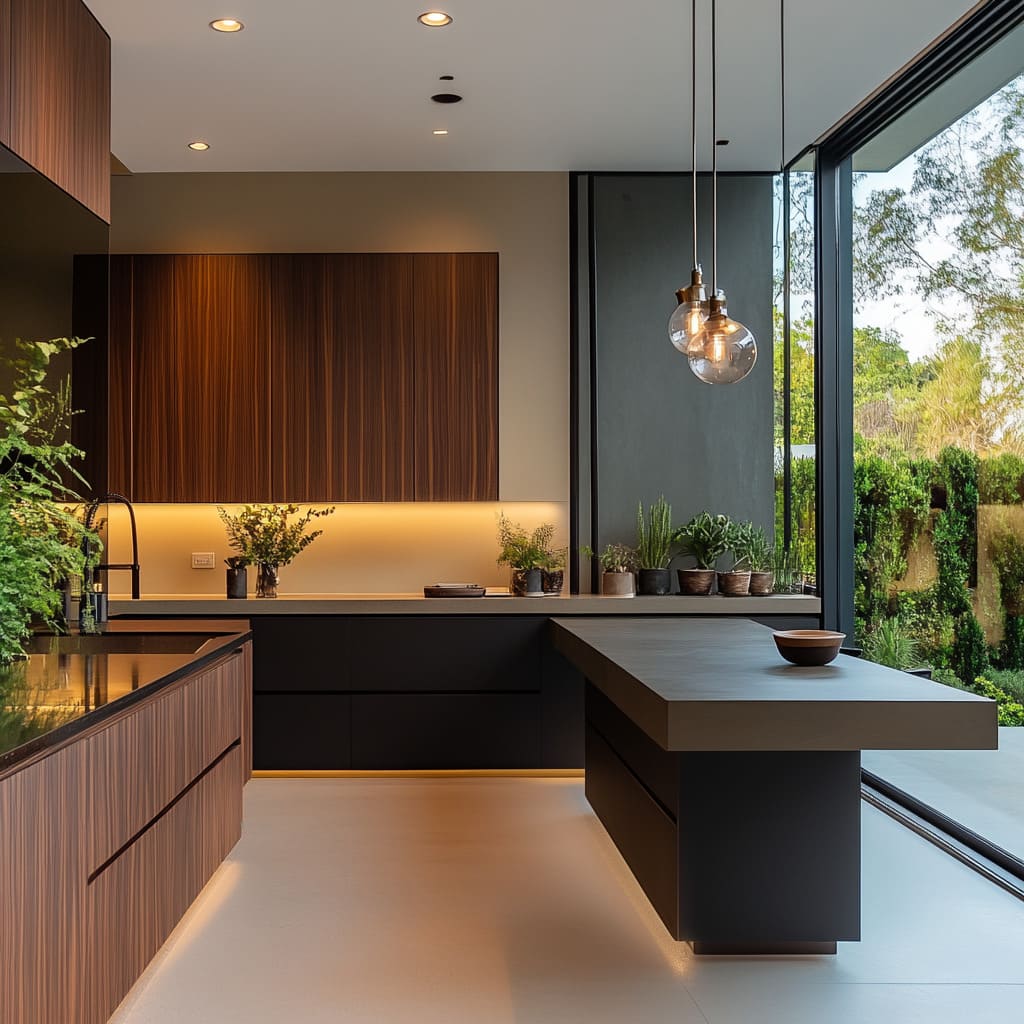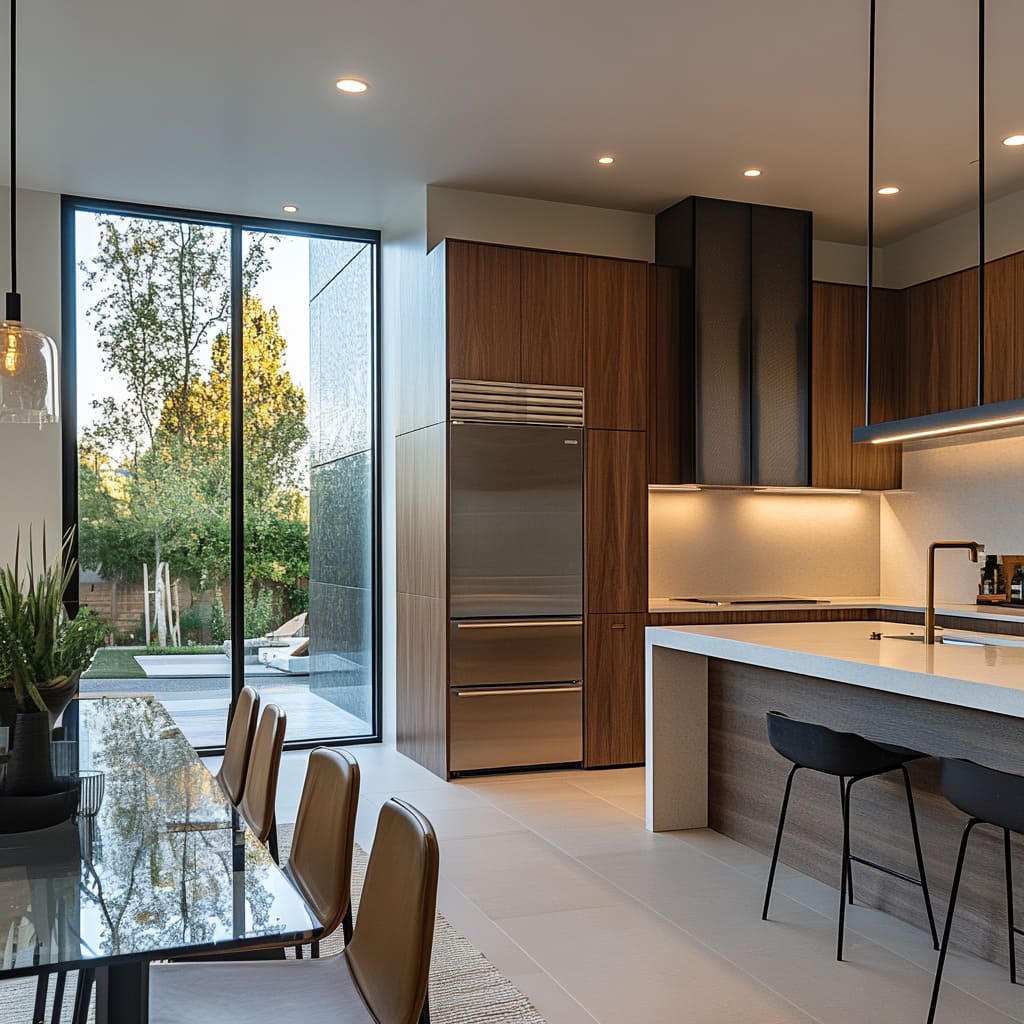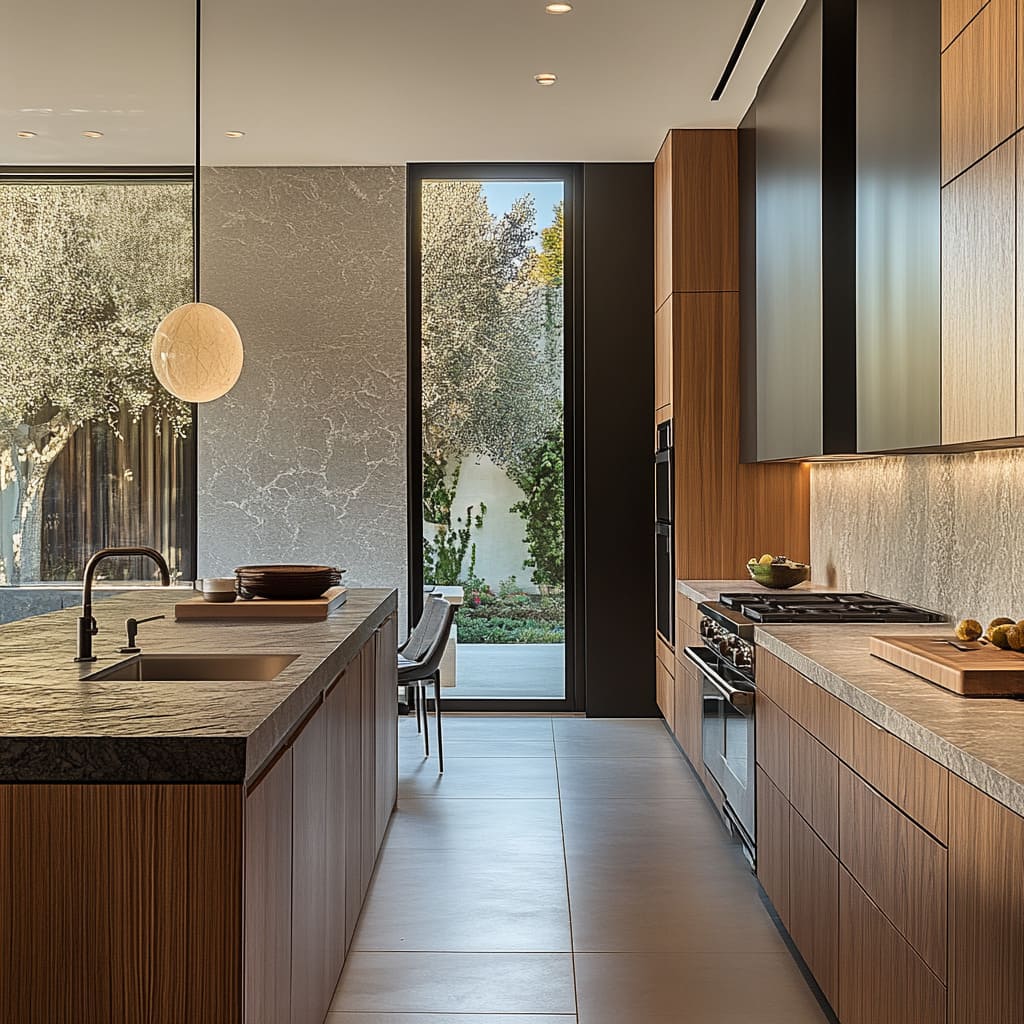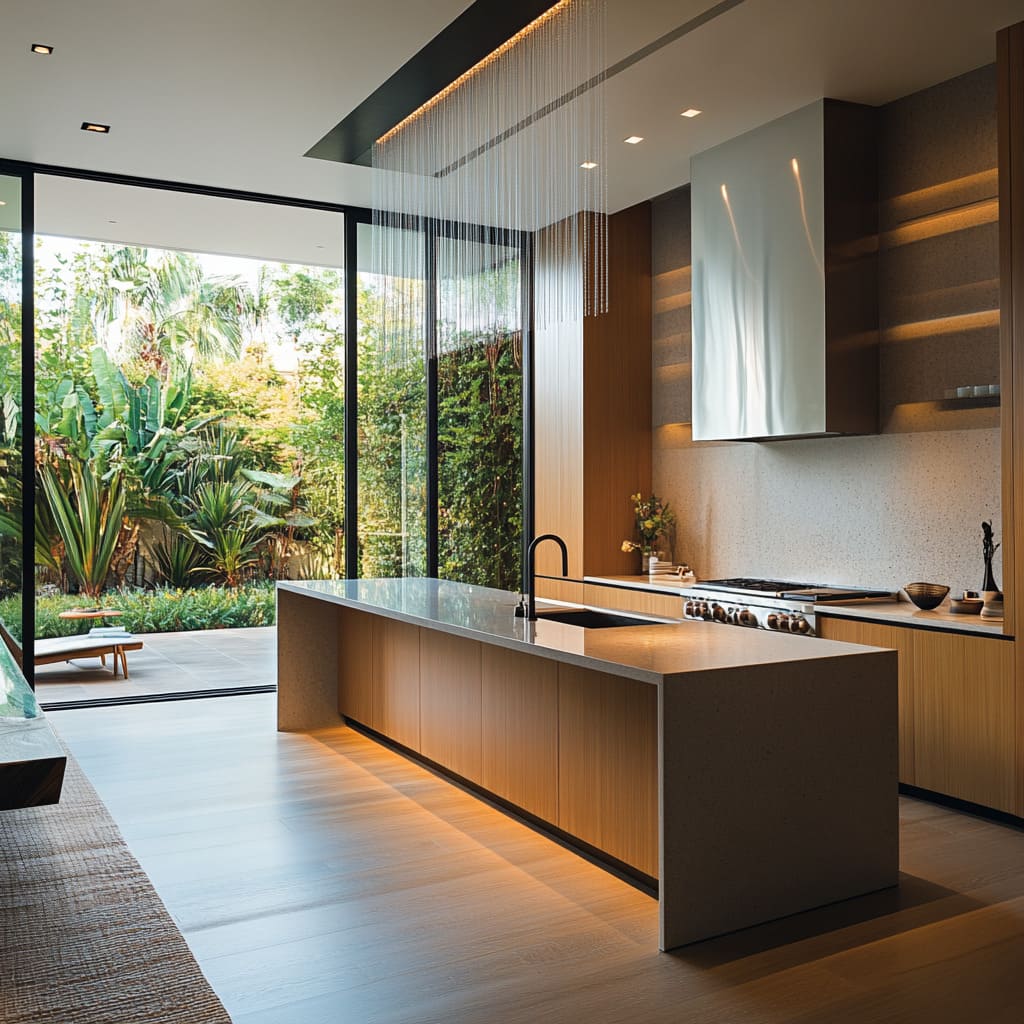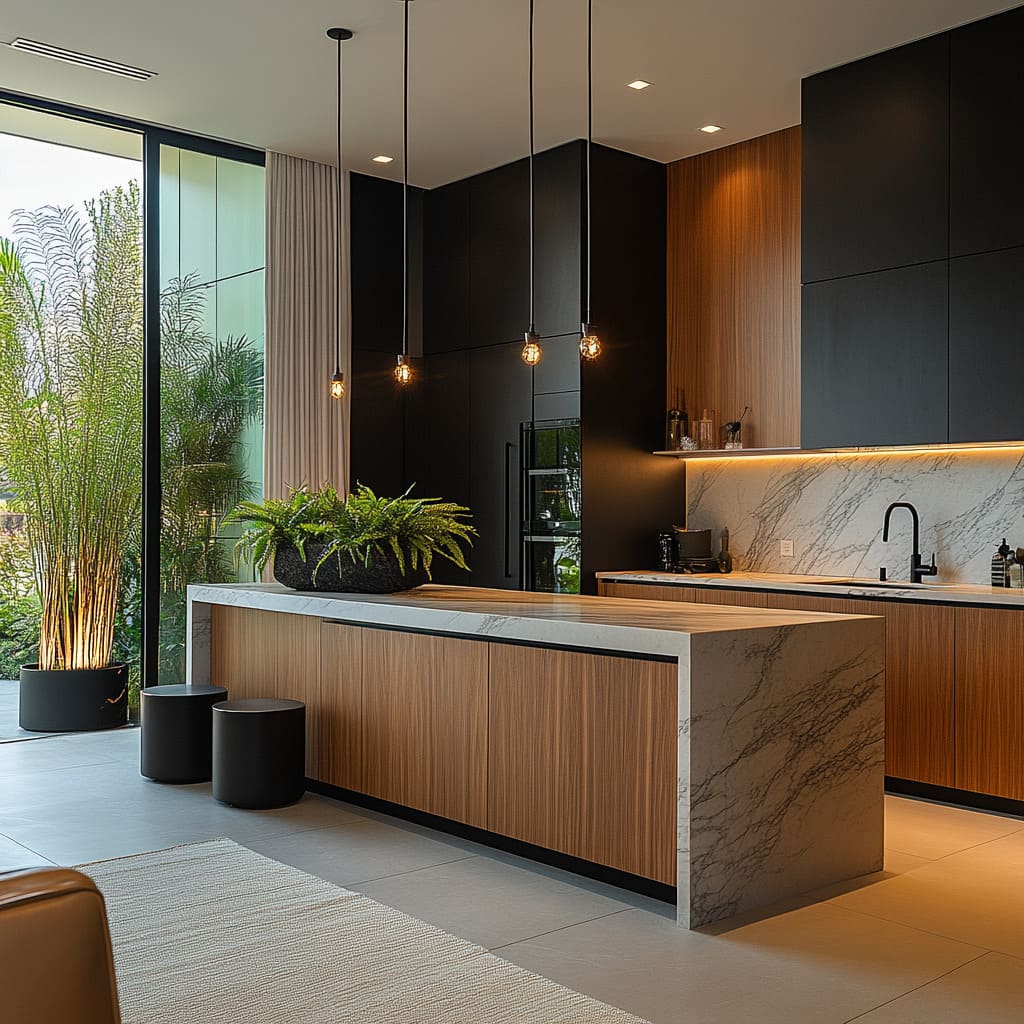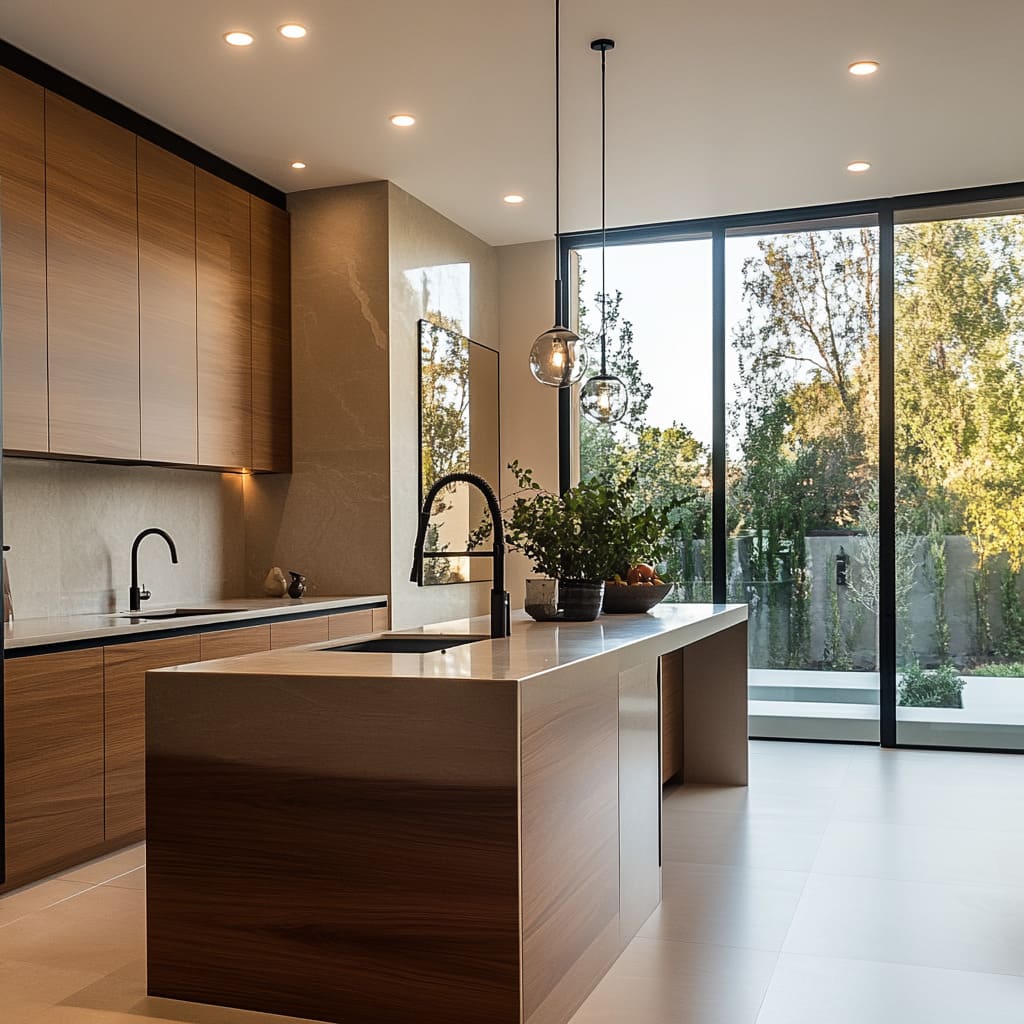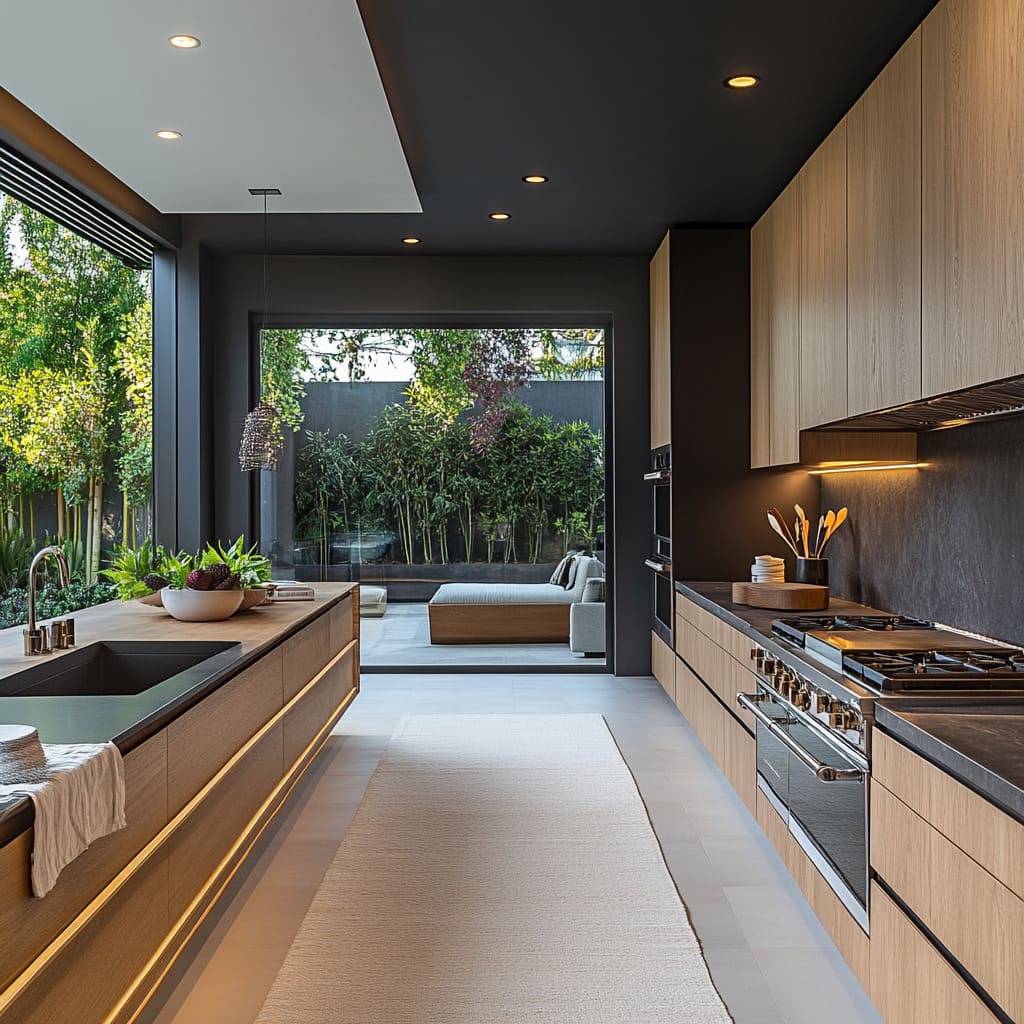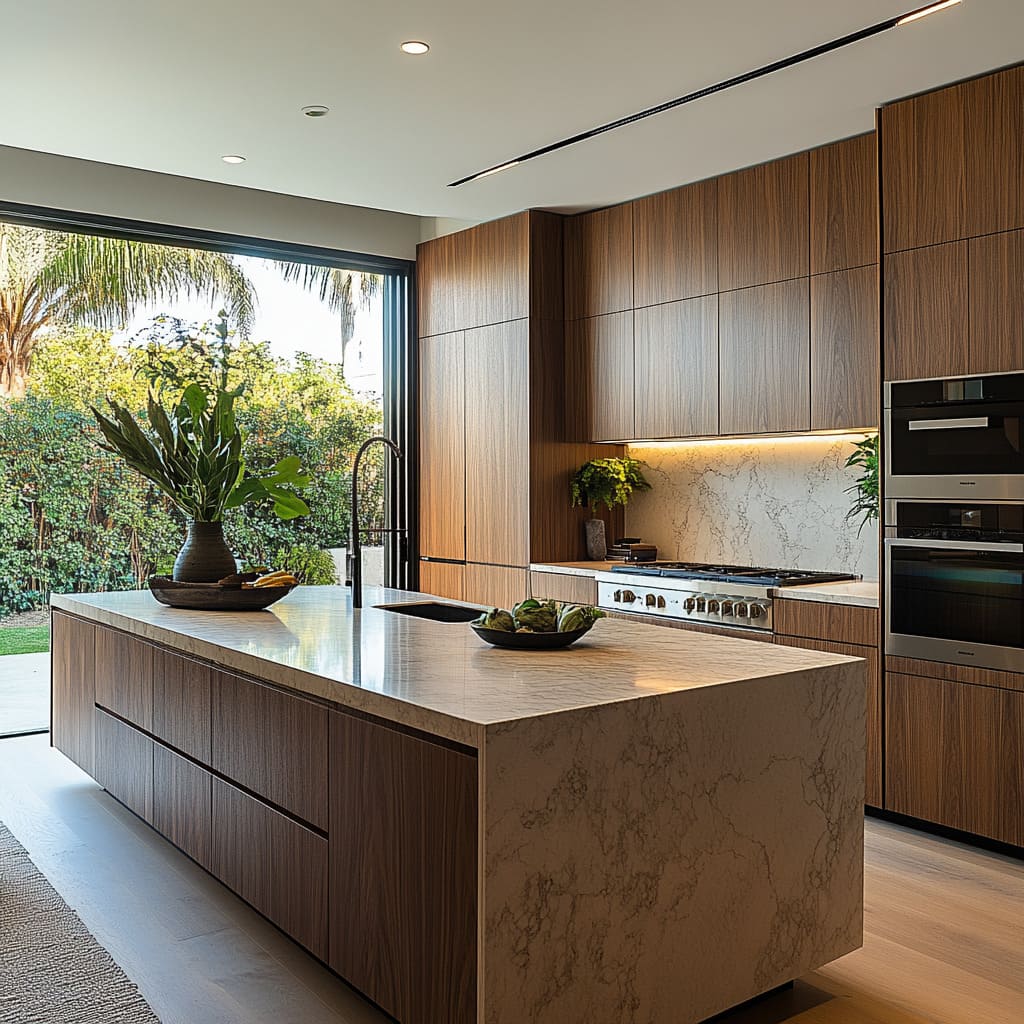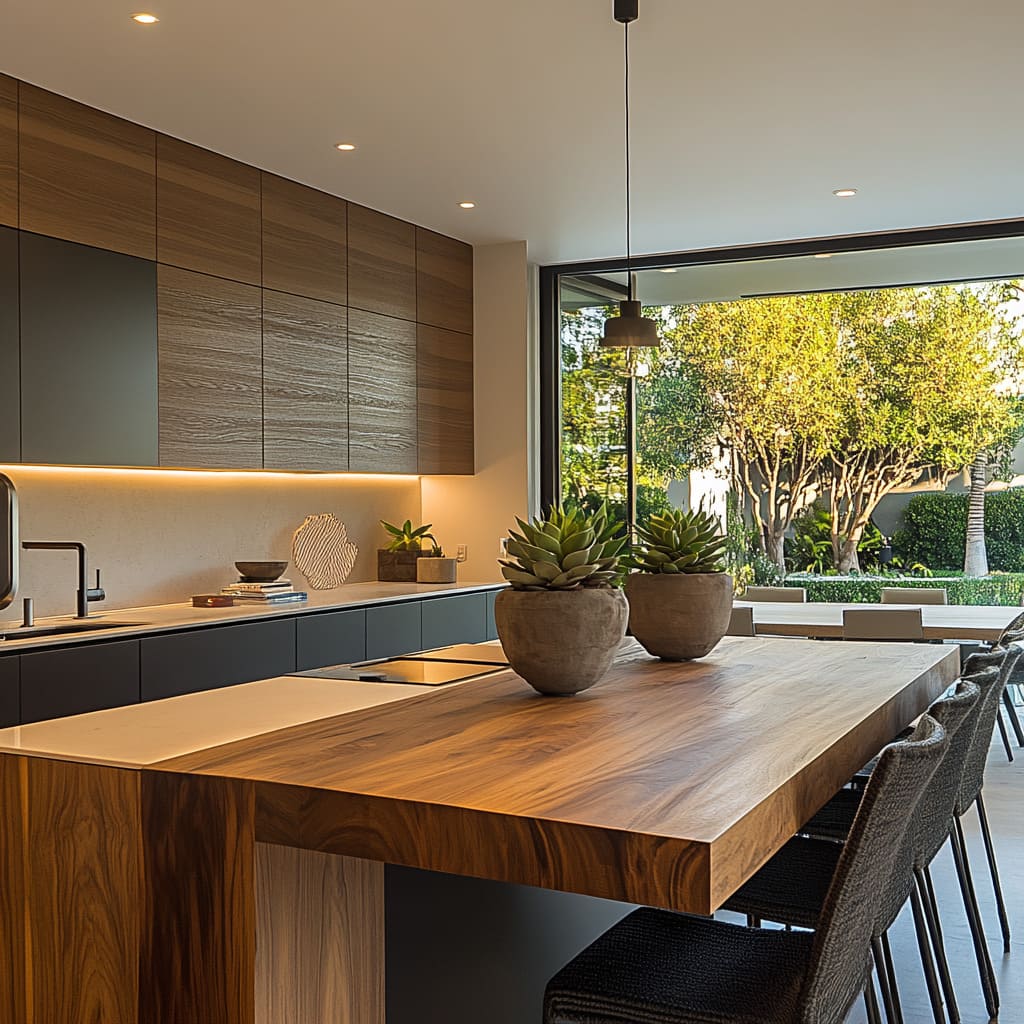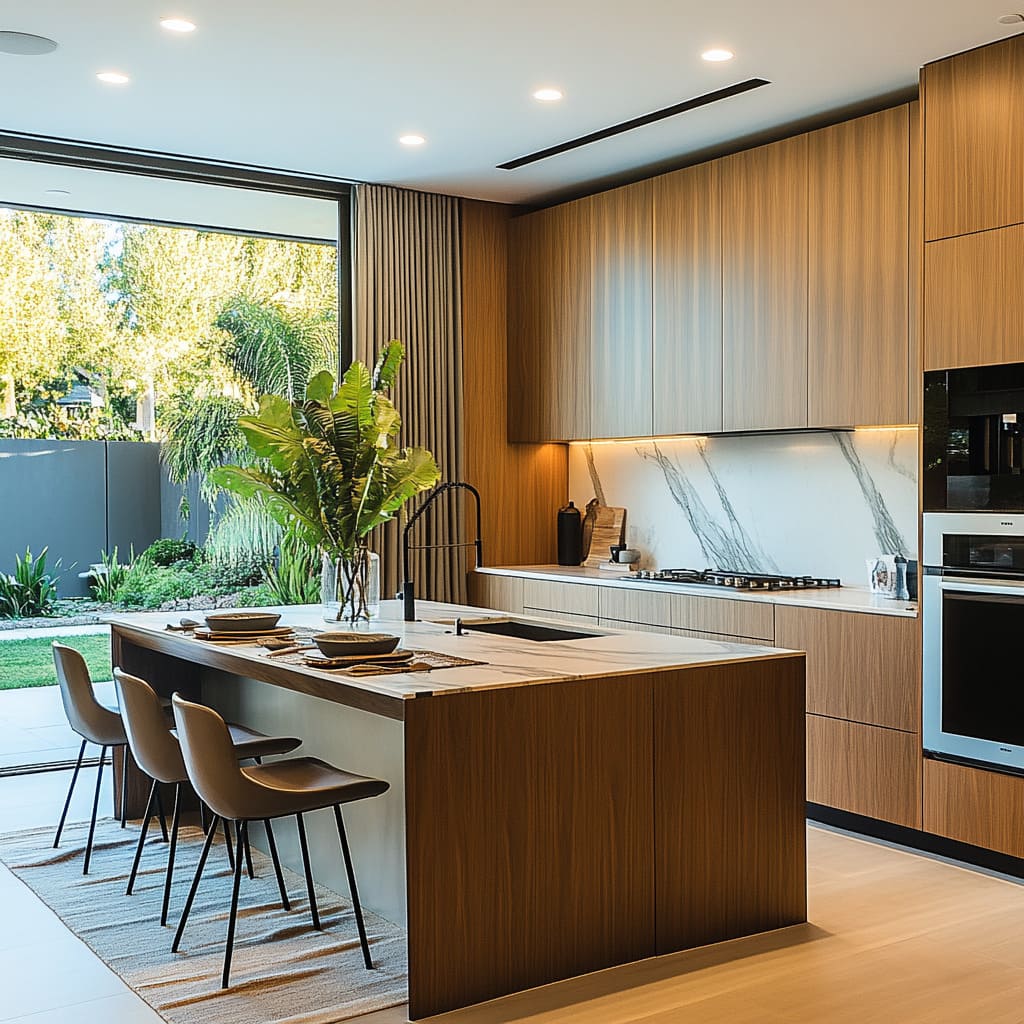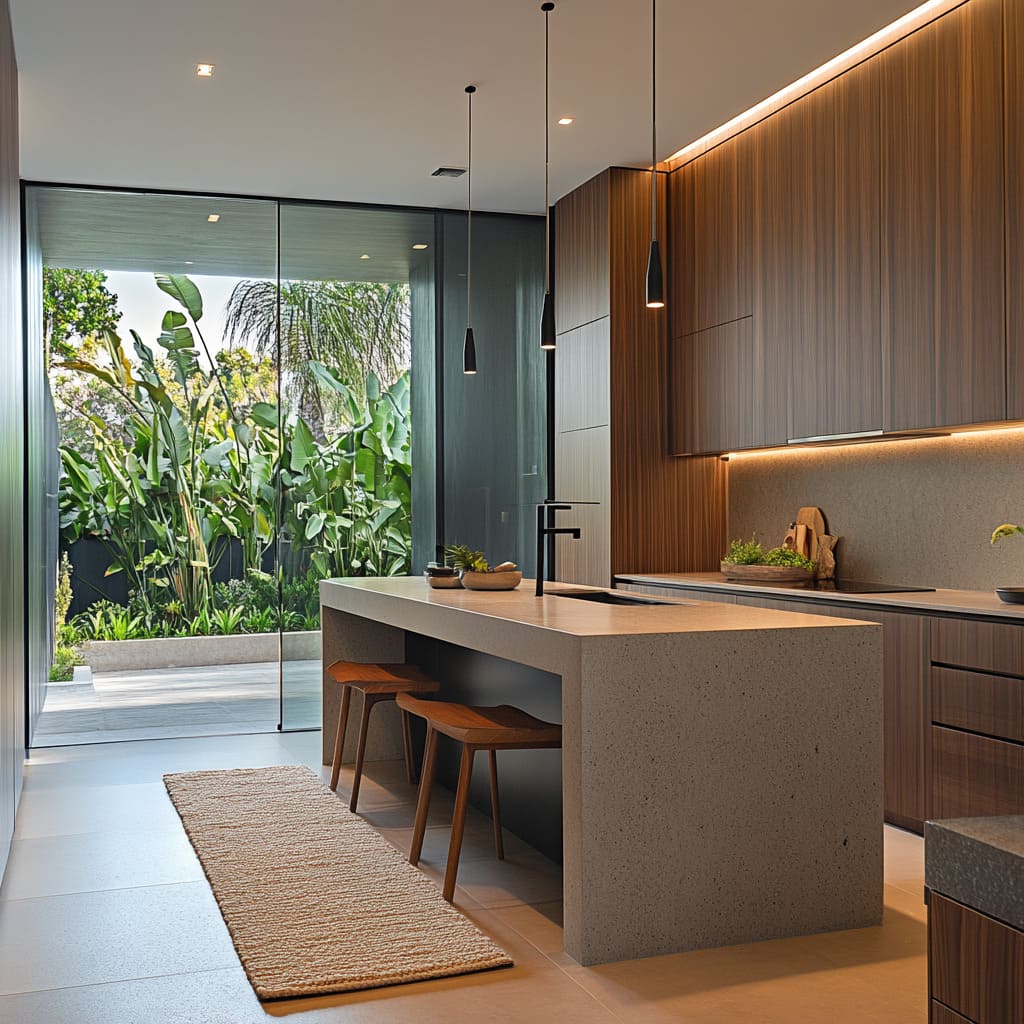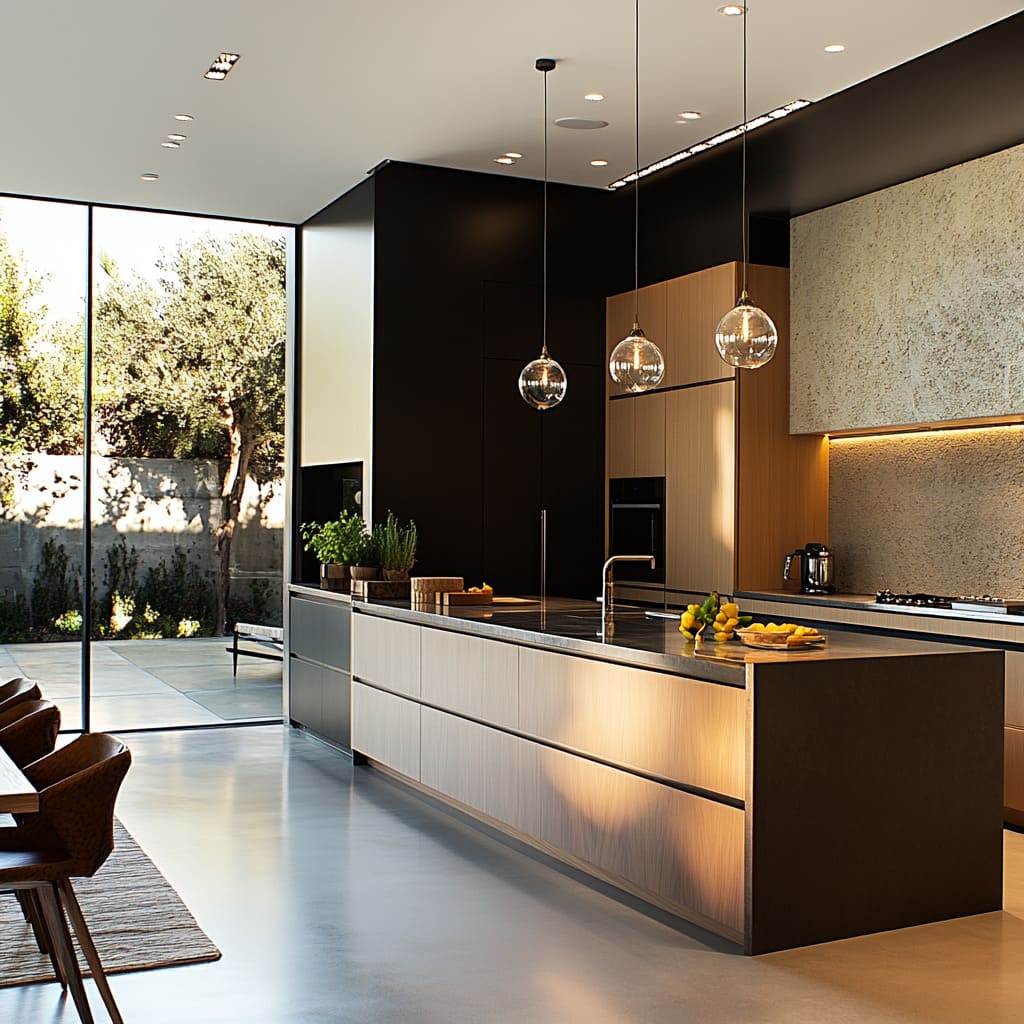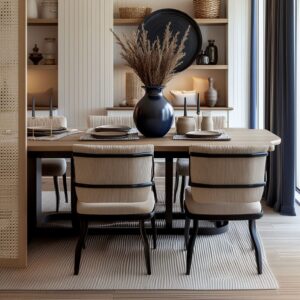Mid-century modern kitchens are making a strong comeback, but in a way that feels fresh rather than nostalgic. Instead of simply repeating iconic elements—like teak cabinets or atomic-inspired lighting—today’s designers blend classic influences with contemporary materials, layouts, and functionality.
This shift results in kitchens that feel both timeless and tailored to modern living. This article takes a closer look at how these spaces go beyond the expected.
While some features are unmistakably Mid-Century—sleek cabinetry, warm wood tones, and open layouts—others are more subtle, hiding in the way lighting is layered, how materials contrast, or even in the architectural choices that shape the space. From dark, moody aesthetics to airy, plant-filled environments, the variety within this style proves it can adapt to different settings and personal preferences.
Instead of focusing only on furniture styles or color schemes, this guide breaks down the details that define contemporary kitchens influenced by Mid-Century Modern design. Whether it’s a carefully chosen ceiling treatment, a seamless indoor-outdoor connection, or the perfect balance of natural textures and modern finishes, these insights will help you see what makes these kitchens feel both stylish and functional.
Creating Depth and Character with Ceiling Design and Lighting
A well-designed ceiling does more than cover the top of a space—it sets the stage for how a kitchen feels. Whether extending visual lines, introducing contrast, or shaping how light interacts with materials, the ceiling plays a significant role in contemporary kitchen design.
Thoughtful choices can make a kitchen feel more spacious, intimate, or even sculptural, all while reinforcing a seamless flow between living areas.
Expanding Space with Continuous Wood Ceilings
One of the most effective ways to create a visually larger space is by extending the same ceiling finish beyond the kitchen. A mid-century kitchen often benefits from this approach, using warm wood panels that stretch into adjoining rooms.
This technique makes the ceiling feel like an uninterrupted plane, drawing the eye beyond the kitchen and softening transitions between open-plan spaces. To enhance this effect, designers often integrate discreet LED strips along the ceiling perimeter.
These hidden light sources subtly define the architecture without the need for bulky fixtures, casting a soft glow that adds dimension while keeping the focus on the materials themselves. The result is a ceiling that doesn’t just blend in—it becomes a defining feature of the entire space.
The Unexpected Appeal of Dark Ceilings
While many homeowners focus on keeping ceilings light and bright, darker tones have their own advantages. A black or charcoal ceiling in a contemporary kitchen may seem like a bold choice, but it creates a sense of intimacy, making the space feel grounded rather than overwhelming.
This approach works particularly well when paired with lighter floors and cabinetry, balancing the contrast so that the room feels inviting rather than heavy. The key is to use dark ceilings strategically.
In kitchens with high ceilings, a deeper shade overhead can visually lower the ceiling, creating a more comfortable and intimate atmosphere. It also helps define the space in an open-concept layout, setting the kitchen apart without the need for walls.
In smaller kitchens, a dark ceiling with well-placed lighting can add drama without making the space feel closed in.
Sculptural Lighting That Defines the Kitchen
Lighting is more than a necessity—it’s a design element that shapes how a kitchen is experienced. Instead of using basic pendant lights, many modern kitchens incorporate cascading metal rods, asymmetrical clusters, or suspended linear fixtures that double as architectural features.
These installations do more than provide illumination. They introduce movement and depth, acting as visual dividers between kitchen zones without blocking sightlines.
For example, in an open-plan kitchen, a series of hanging lights can mark the boundary between the cooking and dining areas, creating a natural sense of separation without needing a physical partition.
When selecting lighting, the best results come from layering different sources. A mix of recessed lighting, under-cabinet LEDs, and statement pendants ensures that every surface is well-lit while maintaining a dynamic, visually engaging space.
Whether the goal is to highlight natural wood tones, soften darker cabinetry, or add a sculptural element to the ceiling, the right lighting choices bring the entire design together.
Countertops and Islands That Shape the Kitchen’s Identity
A kitchen island is more than a functional surface—it’s the element that anchors the entire space. Whether floating effortlessly above the floor, layering contrasting materials, or wrapping stone seamlessly over its edges, an island sets the tone for the kitchen’s style and flow.
Thoughtful countertop and island design can make a kitchen feel more open, introduce sculptural qualities, and subtly nod to mid-century influences.
Floating and Cantilevered Islands: The Illusion of Weightlessness
One of the most striking techniques in contemporary kitchens is the use of cantilevered or floating islands. By recessing the base or extending the countertop outward with minimal support, designers create the illusion that the island is suspended in mid-air.
This concept has strong roots in mid-century architecture, where clean lines and gravity-defying structures were key design principles. Beyond aesthetics, floating islands serve a practical purpose.
By exposing more of the floor beneath, they make the space feel lighter and more open, a valuable trick for smaller kitchens or open-concept layouts. Paired with concealed LED lighting underneath, the effect becomes even more pronounced, as soft illumination enhances the floating appearance at night.
Layered Countertops: Mixing Materials for Depth and Function
A single slab of stone can be striking, but layering different materials on an island introduces a level of depth that makes the design more dynamic. In many cases, a smooth stone prep surface is combined with a raised wooden ledge, creating a natural separation between the working and dining zones of the kitchen.
This approach is particularly effective in mid-century modern kitchen islands, where the fusion of natural wood and sleek industrial surfaces reflects the material contrast that defined the era. Layered countertops also bring a tactile quality to the kitchen.
The warmth of wood balances the coolness of stone, while subtle height variations add movement and visual rhythm. Beyond aesthetics, the functional separation allows homeowners to designate different areas for meal prep, serving, and casual dining without breaking up the flow of the island.
Waterfall Edges: Creating Seamless Architectural Forms
The waterfall edge has become a signature feature in modern kitchen design, but beyond its visual appeal, it serves a larger purpose. By extending the countertop material down the sides of the island, designers create a continuous surface that eliminates visual breaks, reinforcing a sense of unity in the space.
This approach recalls the monolithic stone furniture pieces often found in mid-century interiors—clean, sculptural, and grounded in natural materials. Whether using veined marble, textured quartz, or honed concrete, a waterfall island blends durability with an effortless flow between vertical and horizontal planes.
Waterfall edges are especially impactful in kitchens that embrace minimalism, allowing the material itself to take center stage. When paired with handle-free cabinetry, the island becomes a bold yet understated centerpiece, shaping the entire character of the kitchen without the need for excessive detailing.
By rethinking how kitchen islands function—not just as workstations, but as architectural elements—these design choices create a space that feels more connected, purposeful, and visually compelling.
Cabinetry: A Balance of Texture, Contrast, and Seamless Design
The right cabinetry does more than provide storage—it defines the visual rhythm of the kitchen. Whether through the use of vertical wood grains, contrasting upper and lower tones, or hidden hardware, these elements contribute to a sleek, modern aesthetic while maintaining a connection to mid-century design principles.
Mid-century modern kitchen cabinets blend simplicity with function, favoring clean lines and warm materials that create a refined yet inviting atmosphere.
Vertical Wood Grains: Elevating the Perception of Space
Mid-century interiors have always embraced linear forms, and in kitchen cabinetry, this translates into vertical wood grains that subtly guide the eye upward. Instead of horizontal patterns that emphasize width, the top-to-bottom alignment of wood veneer or laminate makes ceilings feel taller, lending an airy quality to the space.
This technique works especially well in kitchens with standard ceiling heights, where the goal is to create a sense of openness without adding unnecessary visual weight. The effect is even stronger when paired with full-height cabinetry that eliminates upper cabinet gaps, reinforcing the clean, uninterrupted lines that define both contemporary and mid-century kitchens.
Two-Tone Cabinetry: Contrast That Feels Balanced
Mixing light and dark cabinetry is a thoughtful way to add dimension without overwhelming the space. A common strategy is keeping upper cabinets in a lighter wood or neutral paint color while grounding the lower section with deeper walnut, oak, or matte finishes.
This method allows the kitchen to feel more open at eye level while providing visual weight below, ensuring the design remains balanced. The inspiration for this approach comes from mid-century interiors, where warm wood tones were often contrasted with pale walls or neutral accents.
Today, this combination continues to work well, especially in kitchens with high ceilings or open layouts where too much of one finish can feel monotonous. The right contrast creates warmth while maintaining a streamlined, architectural feel.
Hidden Hardware: The Beauty of Seamless Design
One of the most defining characteristics of modern and mid-century-inspired kitchens is the absence of bulky hardware. Instead of traditional handles or knobs, many kitchens now feature integrated pulls, negative space cutouts, or push-to-open mechanisms that allow cabinetry to remain uninterrupted.
This approach highlights the texture of the wood grain or matte finish, letting the materials take center stage rather than being broken up by hardware.
The choice to go handle-free isn’t just about aesthetics—it also makes for a smoother, more functional kitchen. With fewer protruding elements, cabinetry stays sleek and easy to maintain, aligning with the idea that kitchens should be both stylish and practical.
Whether using flat-panel doors in deep wood tones or a mix of materials, the lack of visible hardware keeps the space feeling refined and cohesive. Through a combination of vertical alignment, contrast, and minimalist detailing, cabinetry becomes an integral part of the kitchen’s architecture rather than just a storage solution.
These design choices create a space that feels both timeless and deeply connected to the clean, thoughtful approach of mid-century interiors.
Monochrome vs. Earthy Palettes: The Mood of the Kitchen
Color is one of the most powerful tools in shaping the mood of a kitchen. While layout and materials define the structure, the choice between deep monochromes and warm, earthy tones influences how the space feels on a daily basis.
A well-balanced palette can create a sense of calm, highlight architectural details, or even add an element of drama. Whether a kitchen leans into darker tones for a striking effect or embraces neutral hues for a softer look, color plays a defining role in achieving the right atmosphere.
The Impact of Dark Monochromes
Deep, moody tones—charcoal, matte black, deep walnut—bring a strong presence to a kitchen, making every design detail stand out. This approach works especially well when paired with natural light or reflective accents like brushed brass or stainless steel.
A mid mod kitchen with darker finishes can feel intimate, yet sophisticated, much like the cozy conversation areas that were a staple of Mid-Century homes. One of the benefits of dark tones is their ability to define a space in an open-concept layout.
By using a deep monochrome for cabinetry or a feature wall, the kitchen gains a distinct identity without the need for structural dividers. The contrast between dark finishes and lighter floors or countertops creates an interplay of light and shadow, adding dimension that makes the design feel intentional rather than heavy.
For those concerned about a kitchen appearing too dark, subtle textural differences can keep the palette from feeling flat. Matte black cabinets with a wood grain texture, honed stone countertops, or a slightly reflective backsplash introduce just enough variation to add depth without overpowering the space.
Earthy Neutrals: A Softer Approach
While darker monochromes add boldness, a softer mix of neutrals—warm taupe, light gray, creamy white—creates a sense of calm. When blended with natural wood, these colors reflect the easygoing yet refined side of Mid-Century interiors, where functionality and comfort were equally important.
Lighter monochromes help kitchens feel open and inviting, making them a great choice for spaces with limited natural light. A combination of warm wood cabinetry and pale quartz countertops can create a balanced, organic look that doesn’t feel sterile or overly modern.
This approach works particularly well in kitchens where the goal is to achieve a timeless aesthetic that still feels contemporary. The key to making a neutral palette visually engaging is to mix in materials that add subtle contrast.
Wood paneling on an island, textured stone backsplashes, or even soft linen-toned barstools can introduce warmth without disrupting the simplicity of the design.
The Role of Subtle Patterns in Backsplashes
Backsplashes serve as a bridge between countertops and cabinetry, and in Mid-Century-inspired kitchens, they are often understated yet rich in texture. Instead of bold tile patterns, many designers opt for terrazzo, lightly veined stone, or a plaster-like finish that adds depth without becoming a focal point.
This aligns with the Mid-Century preference for natural materials that age gracefully and complement, rather than compete with, other design elements. For a monochrome kitchen, a textured backsplash can soften the effect of darker tones, preventing them from feeling too rigid.
In lighter kitchens, a soft-patterned stone can provide just enough movement to keep the space from appearing too uniform. Whether a kitchen embraces deep, moody hues or soft, inviting neutrals, the right color choices help shape the experience of the space.
With careful balancing, both approaches can bring warmth, style, and a timeless quality that makes the kitchen feel like an extension of the home’s personality.
Indoor-Outdoor Connections That Go Beyond Just Large Windows
Bringing the outdoors in has always been a defining feature of Mid-Century design, but in contemporary kitchens, this idea extends far beyond simply installing oversized glass doors. The way materials, greenery, and architectural framing are used can blur the boundary between indoor and outdoor spaces, creating a seamless experience that enhances both aesthetics and functionality.
Flooring That Flows Effortlessly Between Spaces
One of the most effective ways to create continuity between a kitchen and its outdoor counterpart is by using the same flooring inside and out. Whether it’s polished concrete, large-format stone tiles, or warm wood decking, this approach extends the visual plane beyond the walls of the kitchen.
Even when doors remain closed, the uninterrupted flooring makes the interior feel like an extension of the landscape, reinforcing the open and airy quality that Mid-Century homes are known for. In contemporary homes, this technique works especially well in kitchens with sliding or folding glass doors.
When opened, the transition between spaces is nearly invisible, making outdoor dining areas or patios feel like a natural extension of the kitchen. This effect isn’t just about aesthetics—it also changes how the space is used, encouraging a more flexible, open style of living.
Greenery as an Extension of the Kitchen
Plants have always played a role in home design, but their placement in modern kitchens goes beyond decoration. Instead of simply adding a few potted herbs on a windowsill, designers often position tall planters near large glass openings, aligning them with outdoor landscaping to create layered views.
This way, when looking out from the kitchen, the greenery inside merges seamlessly with the garden beyond, making the distinction between indoor and outdoor space nearly imperceptible. In kitchens with more limited access to the outdoors, strategically placed greenery can still create a similar effect.
Hanging plants above an island, vertical gardens on a feature wall, or even a collection of oversized potted plants near a dining nook can bring in natural elements while maintaining the clean, uncluttered look that modern designs favor.
Windows That Frame Nature Like Art
Not every home can accommodate floor-to-ceiling glass walls, but even smaller, carefully placed windows can create a strong connection to the outdoors. A single vertical window at the end of a galley kitchen, for example, can transform what might otherwise be a plain wall into a framed view of a tree, a small courtyard, or a sculptural plant.
This approach works particularly well in kitchens that incorporate mid-century kitchen cabinets, where the clean lines and warm wood tones naturally complement organic materials. By positioning windows to frame specific features rather than just opening up to a general view, the design feels intentional—almost like a living artwork that changes with the seasons.
By thinking beyond traditional ideas of open-concept design and considering how materials, greenery, and architecture interact, a kitchen can feel effortlessly connected to its surroundings. Whether through a continuous floor, carefully placed plants, or windows that turn nature into a design element, these details ensure that the relationship between indoors and outdoors is both practical and visually compelling.
Subtle Textural Contrasts That Bring Minimalist Kitchens to Life
Minimalist design isn’t just about simplicity—it’s about using materials in a way that keeps the space from feeling flat. In kitchens inspired by Mid-Century aesthetics, subtle textural contrasts add depth without overwhelming the clean, modern aesthetic.
Whether it’s the natural rhythm of slatted wood, the softness of matte finishes, or the reflective qualities of glass, these details create layers that keep the design visually engaging.
Slatted Wood and Fluted Panels: Adding Movement to Surfaces
One of the most effective ways to introduce texture in a kitchen is through vertical slats or fluted panels. These elements create rhythmic lines that shift with natural light, casting soft shadows throughout the day.
Whether used on a feature wall, island base, or as part of mid-century cabinetry, the effect adds depth while maintaining a sense of refinement. This approach works particularly well with warm wood tones, enhancing the organic feel that Mid-Century interiors are known for.
A slatted wood panel on an island, for example, can create a sculptural effect while subtly referencing classic furniture pieces from the era. When combined with smooth countertops or matte cabinetry, the contrast between linear texture and sleek surfaces keeps the design balanced.
Matte Stone and Plaster: Softening the Kitchen’s Finish
Glossy surfaces often dominate modern kitchens, but a single matte-finished element can completely shift the feel of the space. Whether it’s a rough plaster accent wall or a honed stone backsplash, these materials add a tactile quality that makes the kitchen feel more inviting.
This concept was often seen in Mid-Century homes, where natural materials were used to create subtle contrasts without relying on excessive ornamentation. Today, a matte stone backsplash can provide a gentle break from high-gloss cabinetry, while plaster or lime-wash walls offer a handcrafted texture that softens an otherwise streamlined space.
The key is in the balance—too much texture can feel heavy, but a well-placed accent enhances the overall warmth of the design.
Mirrored and Reflective Upper Cabinets: Expanding Light and Space
While mirrors aren’t typically associated with kitchen design, reflective upper cabinets are a smart way to introduce light and depth without making a space feel cluttered. Instead of acting as a bold statement, these surfaces are used sparingly—often along a single row of upper cabinetry—to subtly reflect greenery, pendant lighting, or outdoor views.
This technique is particularly effective in kitchens with limited natural light, as the reflections help brighten the space without the need for additional fixtures. It also prevents overhead cabinets from feeling heavy, making them appear to recede into the background rather than dominating the room.
When paired with natural materials, reflective cabinetry creates a contrast that feels effortless rather than flashy. The goal is not to introduce a mirrored effect, but rather to enhance the feeling of openness while maintaining the warm, inviting atmosphere that defines Mid-Century-inspired kitchens.
By layering different textures—whether through structured wood, soft stone, or reflective surfaces—modern kitchens can achieve a minimalist look that still feels rich and engaging. It’s these small yet impactful details that turn a simple design into a space that feels thoughtfully crafted.
Lighting as Architectural Sculpture
Lighting does more than illuminate a space—it defines how a kitchen feels and interacts with its surroundings. When thoughtfully arranged, it becomes an architectural feature in itself, shaping the atmosphere while highlighting key design elements.
In modern kitchens with Mid-Century influences, lighting isn’t just functional; it’s an integral part of the design, introducing rhythm, contrast, and depth.
Sculptural Pendants That Work with the Layout
Rather than simply suspending a row of matching pendants above the island, modern designs take a more dynamic approach. By staggering heights, clustering lights in an asymmetrical pattern, or using fixtures with sculptural qualities, designers create focal points that feel intentional and artful.
This layered effect changes the way light interacts with the space, making it feel visually engaging from multiple angles. Pendant lights inspired by Mid-Century design often feature globe-shaped glass, sleek brass finishes, or geometric silhouettes.
When positioned thoughtfully, they do more than brighten countertops—they enhance sightlines and draw attention to architectural features. Whether used above an island, over a dining area, or in a cozy breakfast nook, these lights contribute to the overall character of the space.
Indirect LED Lighting That Shapes the Space
While pendant lights act as statement pieces, integrated LEDs quietly elevate the kitchen’s structure. Beyond standard under-cabinet lighting, LEDs are now commonly placed along floating shelves, recessed toe kicks, or the edges of bulkheads to highlight architectural lines.
This technique mirrors a key principle in Mid-Century modern kitchen ideas: using light to emphasize clean, geometric forms. For example, a thin LED strip placed under an island’s overhang gives it a floating effect, reinforcing the sense of weightlessness often seen in Mid-Century furniture.
Similarly, recessed lighting inside open shelving subtly accentuates materials like wood and stone, making them appear richer and more dimensional. These small details may not stand out immediately, but they contribute to an overall sense of depth and refinement.
By treating lighting as more than a necessity, kitchens gain an extra layer of design that transforms them into more than just workspaces. Whether through sculptural pendants or hidden LEDs, well-placed lighting brings warmth, structure, and a touch of personality to any kitchen layout.
Furniture and Decor Choices: Beyond the Expected
The right furniture and decor choices can transform a kitchen from purely functional to a space with character and warmth. While sleek cabinetry and minimalist surfaces define the structure, it’s the smaller elements—bar stools, decorative accents, and unexpected materials—that add personality.
Mid-Century-inspired kitchens balance simplicity with artistry, using furniture and decor that feels intentional rather than excessive.
The Comfort of Curved Chair and Stool Backs
In a kitchen filled with strong lines and geometric forms, curved seating introduces a sense of ease. Many Mid-Century designs embraced soft, organic curves, which now translate into bar stools with rounded wood or upholstered backs.
This small detail makes a big impact, helping to break up the linear nature of cabinetry and countertops. Curved furniture isn’t just about aesthetics—it’s also about comfort.
A well-designed stool or chair encourages relaxation, making the island or dining area feel more inviting. When paired with natural wood finishes or fabric upholstery, these elements bring warmth to the space without disrupting the clean, modern aesthetic.
Sculptural Decor That Feels Effortless
Decor in a Mid-Century-inspired kitchen should feel curated, not cluttered. Instead of filling open shelves with excessive accessories, the focus is on a few well-placed pieces.
A ceramic vase with an organic silhouette, a minimal framed art print, or a single sculptural bowl on the countertop adds interest without overwhelming the space. This approach aligns with Mid-Century principles of functional beauty—where every object has a purpose and a presence.
A driftwood sculpture, a handcrafted pottery piece, or a set of stacked books on an open shelf can introduce personality while maintaining the clean, understated look of the kitchen.
Organic Materials in Unexpected Places
Mixing natural textures with sleek surfaces is a defining trait of Mid-Century style. Instead of limiting wood and woven materials to furniture, they appear in unexpected places—wicker pendant shades, a live-edge wood slab as part of the island, or woven cane inserts on cabinet doors.
These subtle additions soften modern kitchens, preventing them from feeling too stark or industrial. By thoughtfully incorporating organic elements, the kitchen gains layers of depth without losing its minimalist appeal.
Whether through curved seating, sculptural decor, or natural materials, these small choices bring warmth, authenticity, and a touch of individuality to the space.
Bringing It All Together
A well-designed kitchen with Mid-Century Modern influences isn’t just about recognizable furniture silhouettes or wood paneling—it’s about creating a space where materials, textures, and proportions work in harmony. The balance between modern precision and natural warmth is what makes these kitchens feel both contemporary and timeless.
The key lies in contrasts that feel effortless. Polished stone alongside warm wood, matte finishes next to reflective surfaces, and dark cabinetry paired with light countertops all contribute to a space that has depth without feeling overworked.
These material combinations don’t compete for attention; instead, they create a quiet rhythm that adds richness to the design. Beyond materials, architectural flow plays a major role.
Ceilings extend beyond the kitchen to visually connect with adjacent spaces, floor-to-ceiling windows frame outdoor views like works of art, and transitional flooring blurs the boundary between inside and out. These details reinforce the openness and connection to nature that have always been essential to modern design.
Simplicity is another defining characteristic. Handle-free cabinetry, integrated appliances, and seamless storage allow the focus to remain on textures and proportions rather than hardware or ornamentation.
This refined minimalism ensures that the space feels intentional rather than stripped down, proving that modern design doesn’t have to feel cold or impersonal.
Then there are the small details—the elements that make a kitchen feel like an extension of the people who live there. A curved bar stool that softens sharp architectural lines, a sculptural pendant light that acts as a visual anchor, or a fluted backsplash that adds depth without excess ornamentation.
These thoughtful touches subtly reference Mid-Century aesthetics without feeling overly styled or forced. At its best, this approach to kitchen design doesn’t simply recreate the past.
Instead, it builds on timeless principles—balance, proportion, material contrast—and applies them in a way that feels fresh and relevant today. The result is a kitchen that feels effortlessly modern while carrying the warmth and authenticity of a space meant to be lived in.
